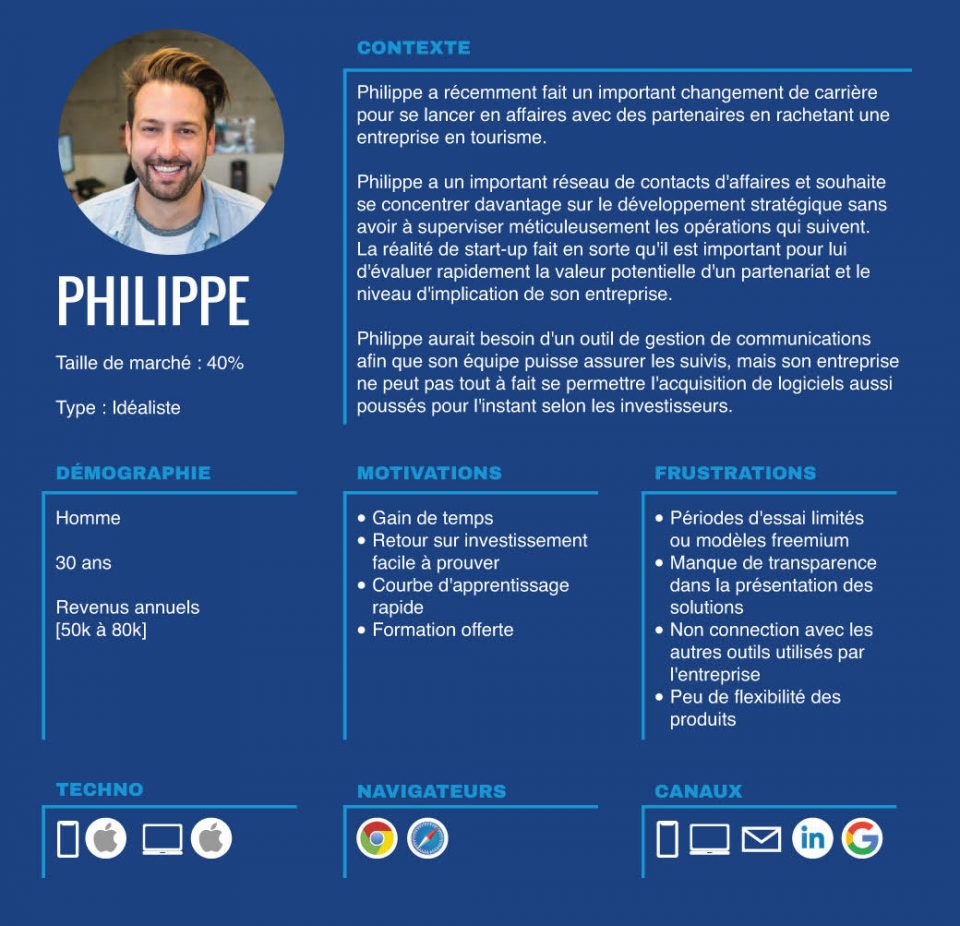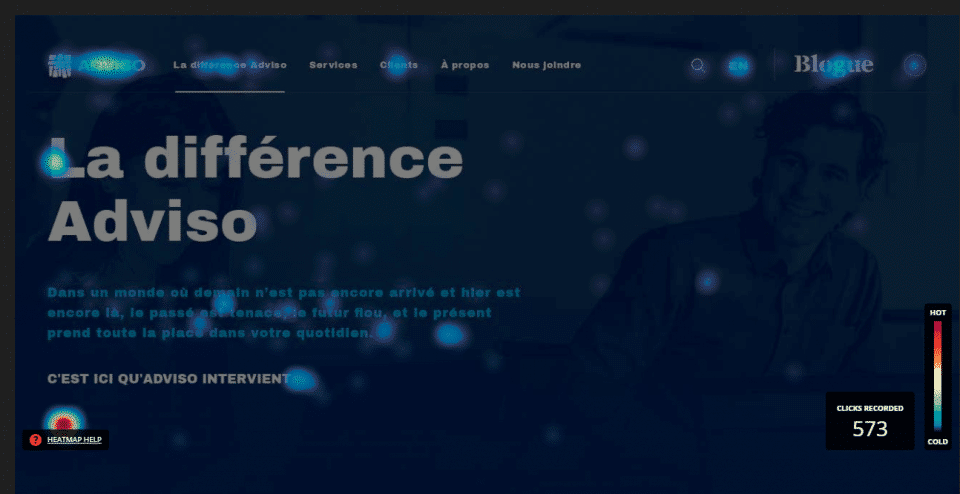Customer Experience Strategist
Why personas are essential
Customer Experience Strategist
How to draw up clear portraits of your customers and prospects? Discover in this article how to define your personas!
Digital never stops evolving and continues to surprise us. What I love about my job is observing and understanding how Internet users interact with websites and mobile applications.
For the past few years, user experience has been central to strategic and tactical thinking (and it’s even more central today). I won’t be explaining the importance of UX (user experience) to your business here—my colleague Jérémie has already done a great job of tackling the subject in this interview.
Instead, we’re going to discuss profiles and how to integrate them into your marketing strategy.
Personas: A standard definition
Let’s take a few moments to define what a profile is. There are a few different definitions, but they all agree that a profile is a semi-fictional representation of your ideal customer. It is produced through performing mixed research (qualitative and quantitative) and consists of demographic, biographical, psychological, and behavioural data. It allows you to understand the profile’s goals and motivations and what they find annoying. Although it’s a fiction, be sure to humanize the profile with a first name and photo.

A single profile represents a category of customer (existing or potential) rather than an individual customer. By developing your personas, you can then map out their various customer journeys to gain a wider perspective.
This involves identifying:
- touchpoints;
- user concerns;
- behaviour;
- satisfaction;
- actions taken after visiting the site.
This list is only partial and needs to be adapted to your particular business reality. Developing your personas will allow you to understand how to foster a lasting relationship with your customers. We will therefore be going beyond a discussion of UX in order to talk about CX (customer experience).
From user experience to customer experience
To illustrate my remarks, I’m going to use a concrete example that will serve as a guide.

Annie is a marketing manager at a company that sells organic meal kits. Their online sales are good, but they’ve experienced a decline in sales since last year.
Annie wants to review her digital marketing strategy. She knows what the target is—women between 20 and 50 living in Quebec—but she’s quickly confronted with a problem: She doesn’t have any concrete idea of who her customers are.
In order to be considered further, this extremely broad question needs to be broken down into segments, such as:
- How can she reach her customers and drive them to the website?
- What do they do on the site?
- How can visitors be converted into customers?
- Why will they choose Annie’s products over that of the competition?
Profile development will therefore be an inevitable part of her new strategy if she hopes to attain her company’s goals.
Quantitative research
To determine her personas, Annie will apply a few different research methods. Data tracking with analytics will enable her to identify certain aspects of these personas. Basically, Annie will be able to know what types of devices her targets use, their geographic location, the time they spend on the site, the pages they look at, the conversions, the subscriptions, where visitors are coming from and other metrics. Don’t forget that your analytics need to be properly configured in order to collect the right insights.
Based on the data collected, Annie takes a look into visitors’ behaviour on the site. She implements a tool that enables sessions to be recorded, which allows her to track the various site interactions and create a map of the heavy interaction zones, also called a heat map.
Example of a heat map of our page The Adviso Difference.

By combining these two research tools, Annie identifies the elements of the site that are detrimental to conversions. However, she still doesn’t have enough data to develop her personas.
Annie needs to know what visitors are doing before they land on the site. To find out, she identifies the organic search trends and keywords they typed in before arriving. These data are important for creating personas. After segmenting user requests, Annie knows what users are concerned about and what they are searching for—she can now adapt her content.
Qualitative research
Among the many qualitative research methods available, such as observation or discussion groups, Annie decides to conduct individual interviews. She needs to make sure she interviews all the different kinds of customer, whether new or recurring, potential or existing. This will enable her to learn about their purchase motivations, what their preferences are, and what annoys them, as well as any opportunities. The interviews will, of course, be based on what is already known about each customer, but a partly unstructured approach is recommended: Annie needs to let her customers speak for themselves!
A portrait will slowly emerge and Annie will be able to notice any disparities, thereby creating several personas out of this information.
HERE’S A TIP
If you only identify a single profile, don’t panic—that’s normal. On the other hand, while there is no magic number, try not to exceed five personas so that you can focus your marketing efforts and prioritize your initiatives. If only one profile emerges, there’s no point creating any others.
If you believe you have all the information you need at this point, you can stop reading here.
Test your hypotheses
In Annie’s case, her research continues. She intends to test her hypotheses using a survey. While this approach is optional, it enables you to evaluate the validity of your potential personas. But she must be careful not to conduct a purely socio-demographic survey—she needs to think about cross-referencing her data.
The analysis of all these indispensable steps has allowed Annie to develop two personas. She then creates worksheets for these personas containing all the information she gathered during her research that distinguish the profile types. With this approach, Annie can now understand her various customers—she can respond to their needs, optimize their purchase experience, and retain their loyalty.
The usefulness of personas
Identifying personas will enable you to orient your content strategy to attract your targeted customers to your site, given that you now understand their concerns and search intent. All you have to do now is offer them the right content.
Your personas can also be used in your media strategies (knowing who to target, how to target them, and what content or products to highlight in your campaigns). For example, Annie could orient the content towards the concerns of one of her personas: How can I be an eco-friendly consumer?
Using behavioural and psychological profile data is essential to offering a good experience on the site. Don’t forget that you can’t have a successful experience without ergonomic design! Users’ experience on the site must respond to their needs, habits, and motivations and avoid annoying users to the point of impeding them. Personas are indispensable to UX design. Don’t put your site creation at risk by not conducting any user research. Optimizing your site’s key pages will enable you to better respond to your personas’ needs and help lead them towards conversion.
The use of profile data doesn’t stop at conversion—you should also use them to increase customer loyalty through a relational marketing strategy. How should you stay in touch with customers? What content should you show them? In what format? How frequently? The answers to all these questions can be found in your profile worksheets.
The exploratory phase can be hard if you don’t know what to look for. Basically, before proceeding with research, it’s important to create a list of questions that is answered by your personas.
Takeaways?
The bottom line is that creating personas enables you to advance your marketing strategy in every sense by responding to customers’ specific needs and making them happy.
Believe it or not, personas underlie everything.
P.S. Psssst! Personas are also very useful for lead generation strategies! #MarketingAutomation







